Over the last 15 or so years, the sniper rifle in both concept and rifle has changed.It was not until the Vietnam War where a semiautomatic sniper rifle based on the M14 rifle was introduced. However, it did not perform as well as the bolt action counterpart and required a full time gunsmith to keep it working. So the semiautomatic rifle was in limited use with the standard still being the bolt action sniper rifle.
However, in the late 1950s a rifle was designed by Eugene M. Stoner at ArmaLite, Inc. called the AR-10. ArmaLite was a division of Fairchild Engine and Aircraft located in Hollywood, California. This revolutionary rifle was truly “Tomorrow’s Rifle Today,” that was more true than anyone knew back then. Although it never had a chance to compete head-on with the M14 for the next U.S. infantry rifle due to Army politics, as well as the deep rooted thought of a rifle having to be made from steel and wood, the AR-10 did get noticed. During its limited testing it was known to be the most accurate auto loading rifle made as said by the testers from Ordnance Corps. Limited numbers of AR-10 rifles were manufactured in the Netherlands by Artillerie-Inrichtingen. They were manufactured for Dutch Army trials as well as sold in limited numbers to some other countries including, Sudan, Cuba, Italy, Guatemala and Portugal. As predicted, the M14 was adopted and the AR-10 was tossed in the Ordnance Corps scrap heap. The requirement came down to scale the AR-10 down to a .22 caliber and the AR-15 was born. The rights were sold for the AR-15 as well as the AR-10 to Colt’s Patent Firearms Manufacturing Company. Colt went on to produce the AR-15 but ignored the AR-10 design. That was left for other companies to capitalize on. To trace the AR-10 lineage to today’s most advanced sniper rifle we must skip ahead nearly 30 or so years ahead to 1991.
In November of 1991, a Mission Needs Statement was drafted for an Enhanced Sniper Support Team Weapon (SSTW). This was written by Lt. Col. David Lutz while serving as the Program Manager for Infantry Weapons at MARCORSYSCOM at Quantico, VA. This documentation was an effort to restart a cancelled Designated Marksman Weapon program (DMR) based on the M14 which could not be made to do all the things needed in a logistically supportable package acceptable to the Fleet Marine Forces. Its requirement document was weak because it totally lacked objectivity in doing a mission analysis or seeking other viable solutions. At the time, the current SSTW was the M16A2 rifle. This weapon supported the M40A1 sniper rifle in the two man scout sniper team. The M16A2 SSTW was used to engage close-up targets and provide rapid fire suppressive fire if needed. Some noted deficiencies were the M16A2’s poor interface with the soldier when having optics mounted, including night vision. The current issue M855 ball ammunition did not meet the accuracy specifications of a SSTW.
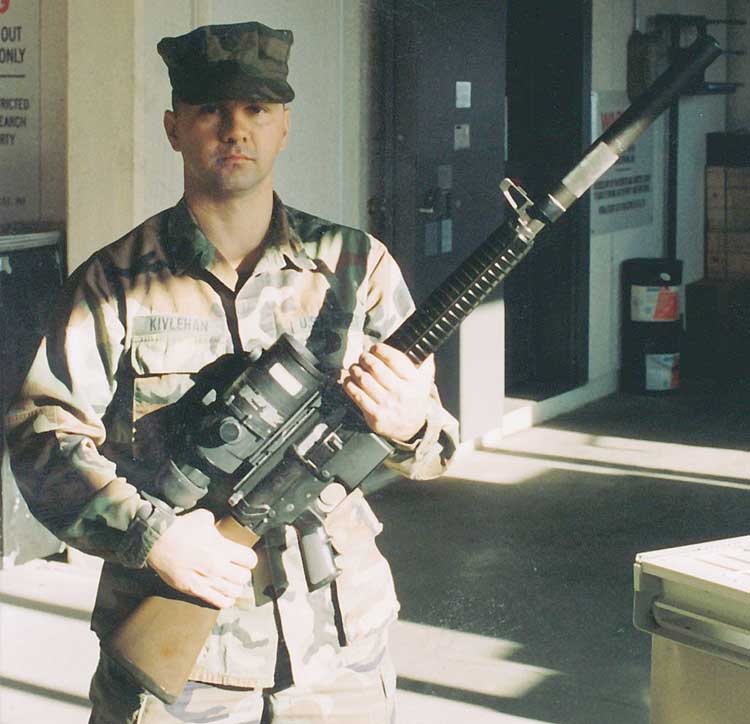
The enhanced SSTW would fill the role of a 0 to 600 meter intermediate range sniper rifle. It would have ammunition interchangeability with the M40A1 7.62x51mm sniper rifle and it would have the ability to mount a sound suppressor. Optics would be mounted in-line with the shooter’s eyes for a comfortable mount. This rifle will also have to overcome current problems with the unit, direct, general, and depot support problems (availability and maintainability) long associated with the hand-built and Marine Corps customized M40A1.

Lt. Col. Lutz recalls that he knew of (5 each) Dutch NATO AR-10s that were in a bunker at Picatinny Arsenal from when he was stationed there during 1980-83. So he had one of his successors, USMC Liaison Officer Maj. Dody Knootz, pick out one that shot the best and “temporary loan” it to them at Quantico. Several modifications were made with the most significant being the carrying handle cut off and a weaver rail attached to the upper receiver. The AR-10 had some of the improved M16A2 components added to it including the pistol grip and handguards. All this was to make it look like and use A2 service rifle parts and training. Additionally, they removed the AR-10’s faux muzzle, which incorporated a grenade launching spigot, exposed its skinny barrel and threaded muzzle. Lutz recalls sending the upper to Phil Seberger to have a suppressor made & fitted to it.

As recalled by Lutz, as a concept demonstrator it was a success. “When my general came out to fire it he brought with him his Australian Army Liaison Officer, a full colonel. My general was reluctant to fire the weapon as I presented it to him, and handed if off to the Australian Colonel. Offhand, the Colonel hit a steel gong at 100 yards with 20 of 20 shots (suppressed). When he handed the rifle back to my general, he said “General, this is the finest rifle I have ever fired.” When the General handed the rifle back to me, he said “Dave, you have a program.” I guess the rest is history…” Though the concept was sound, the Marines or big army were not ready for a semiautomatic sniper rifle, at least not yet. So the AR-10 lay dormant once again until the early 1990s. Even though the original DMR program failed, the STSW maintained life in the requirement and allowed Rifle Team Equipment builders at Quantico to produce more prototype M14 based variants as “interim measures.” This eventually took on a “life of its own,” and an M14 based program eventually found traction as the M39 Enhanced Marksman Rifle (EMR). However, the M39 is one of the weapons being replaced by the Marines recent purchase of M110s. The M110 was inherently able to meet the STSW requirement for mounting of Night Vision without lose of zero, sound suppressor integration, M16 ordnance maintenance and training commonality, supply system commonality and cross-service weapon commonality.
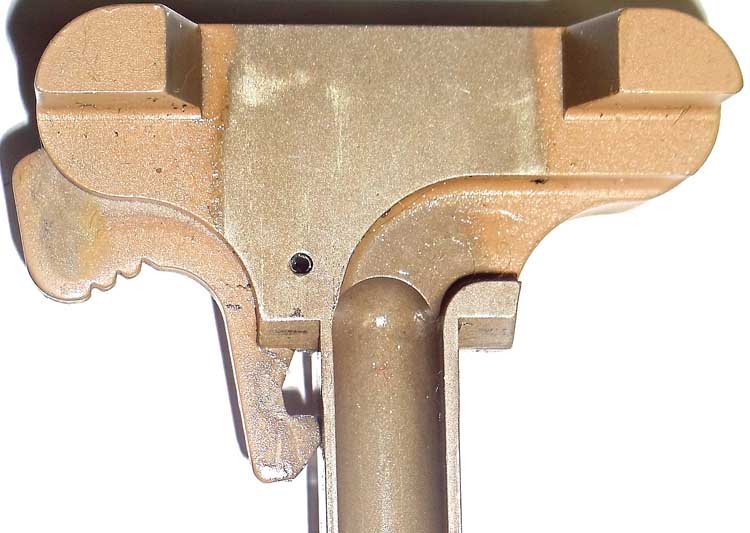
The name Eugene Stoner, although not as well known as Browning, is just as significant in the history of the gun. Stoner’s design is the longest service rifle in U.S. military history. During Stoner’s ArmaLite days his goal was to develop 7.62x51mm weapons. He was very fond of his direct gas system. After the M14 was selected, the future was only in the smaller caliber round so Stoner went on to develop other rifles to fire the 5.56mm cartridge including the AR-18 and the Stoner weapon series. He never quite forgot his AR-10. In the early 1990s, Stoner went to work with C. Reed Knight, Jr., the president of Knight’s Armament Company. The union spawned the rebirth of the AR-10. This would be the SR-25 (Stoner Rifle-25 (15+10)). This rifle would be an AR-10 but would take on the advancements of the M16A2 rifle and maintain 60% parts compatibility.

Released in the early 1990s, the SR-25 Match Rifle was equipped with a 24-inch Remington 5R match grade barrel – the same barrel blanks used on the M24 sniper rifle. The heavy barrel was free floating with a fiberglass handguard. The rifle was equipped with a flat top upper receiver with the Mil-Std 1913 rail and the receivers were made from aluminum extrusions. The rifle was equipped with a 2-stage match grade trigger. The bolt carrier group kept with the original AR-10 in that it was chrome plated and it also sported the captive firing pin retainer pin. These were not mass produced rifles. The uppers and lowers were mated together and had matching serial numbers to identify them. They were specifically designed around the 168gr OTM Match cartridge. Using this factory load, the ogive of the bullet set right on the rifling. This is something match shooters want to accomplish due to not wanting the bullet to “jump” into the rifling thus maintaining control of the projectile right from the moment of chambering. The original rifles used the standard “waffle” pattern 20-round magazine and later a steel magazine that looked more like an M16 20-round magazine in appearance. The SR-25 was sold initially through commercial channels that funded R&D. Every SR-25 was test fired at the factory and provided with a target. Knight guaranteed that this rifle would fire 1 MOA or under with factory ammunition. Gene Stoner would work with Knight up until his death in 1997.
The SR-25 quickly gained its reputation for precision accuracy and reliability and its versatility and benefits were appreciated right away by the special operation forces. SOCOM liked the idea of having a semiautomatic rifle that held 20 rounds of ammunition and rivaled the M24 and M40A1 bolt action rifles. They also liked that you could engage multiple targets in less than half the time they could with a manual bolt action rifle.

After more than 40 years, the AR-10 would have its day. In May of 2000, the U.S. Navy and SOCOM adopted the SR-25 as their new Mk 11 Mod 0. This would be follow by another contract in 2007 for 9.9 million dollars with the need from the Global War On Terrorism. The Mk11 had some departures from the original design. Designed to meet the SOCCOM requirement, the rifle was designed to fire the M118 and M118LR match grade 7.62x51mm NATO ammunition. The Remington barrel was replaced with an Obermeyer barrel and was shortened to 20 inches and equipped with a mount for a quick detachable sound suppressor also developed by Knight’s Armament Company. The 11.35-inch Rail Accessory System free floating handguard provided quad Mil-Std 1913 rails enabling attachment of any given number of accessories including night vision, lasers, tactical lights and bipods. The standard M16A2 stock and pistol grip are used for parts commonality. A flip up front sight was added to the gas block as well as KAC’s fully adjustable back-up iron sight was added. The rifle was equipped with 20-round magazines, a Leupold Vari-X mil dot scope with detachable rings and a Harris bipod. The Mk11 weighs 15.3 pounds unloaded and has an overall length of 45.4 inches. The Mk11 would see action with U.S. Special Operations troops all over the world. The weight of the complete Mk11 Mod 0 with the Leupold 3.5×10 scope & SIMRAD adapter, bipod adapter with LM type S Bipod is 13.7 pounds.
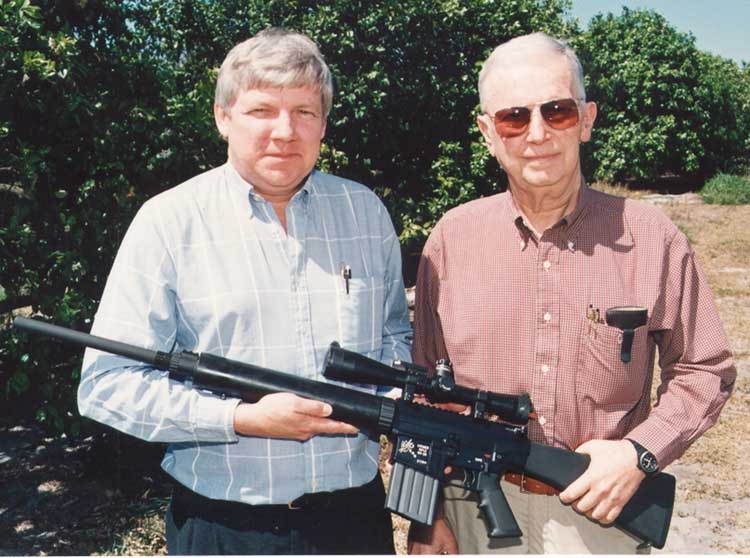
Enter the M110 SASS (Semi Automatic Sniper System)
The success of the Mk11 was undeniable and spread to the other branches of the military – the sniper units in particular. Seeing the benefits in September of 2005, Knight’s won the contract for the M110 SASS rifle. The M110 was to replace the M24 bolt action sniper rifles in the U.S. Army. The M110 trials had many submissions including ArmaLite, Remington and DPMS Panther Arms. It would not be until April of 2008 that the M110 would see its first combat action with U.S. Army snipers from Task Force Fury in Afghanistan. During the early M110 period, the Marines purchased 180 XM110 variants they designated Mk11 Mod 1 and then in 2010 ordered 803 M110 rifles.
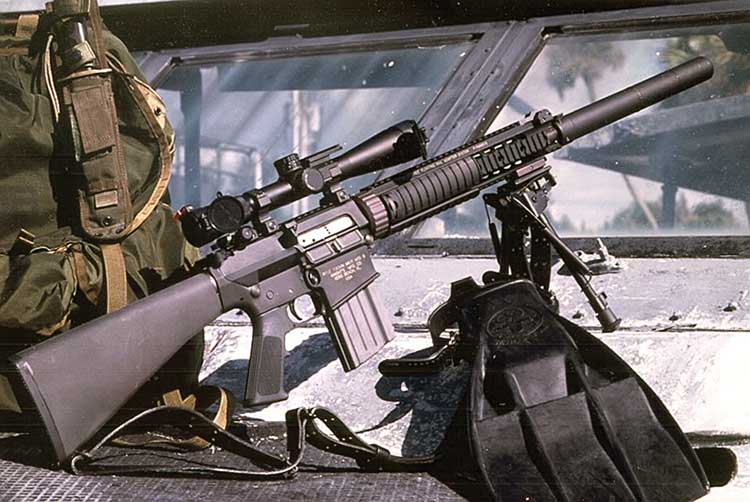
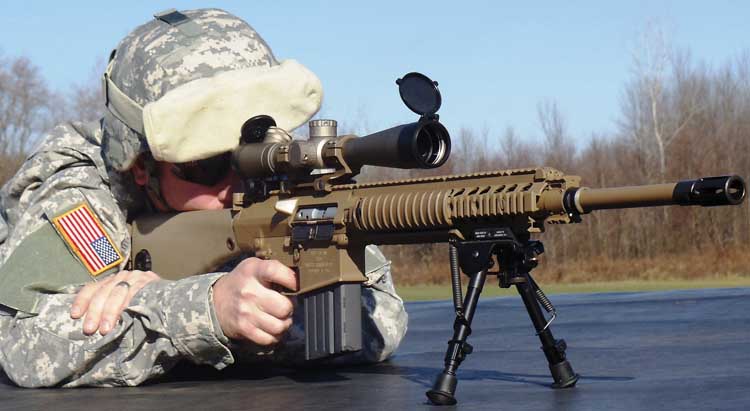
The M110 has many similarities to the Mk11 Mod 0, however with many enhancements. . The stock on the M110 is adjustable for length with a dial on the rear allowing for the length to be increased or decreased as desired. The stock has one moveable sling swivel mount on the bottom rear plus two QD mounts on the front of the stock on each side. The receiver is manufactured from an aluminum forging and incorporates fully ambidextrous selector lever, bolt catch and magazine release. A button right above the magazine catch on the right side of the receiver is the ambi-bolt release. This allows the right handed shooter to release the bolt without his hand ever leaving the pistol grip. On the left side of the receiver under the bolt catch is a button to release the magazine for a left handed shooter. The trigger is Knight’s 2-stage match trigger, which is exceptional for a sniper rifle.
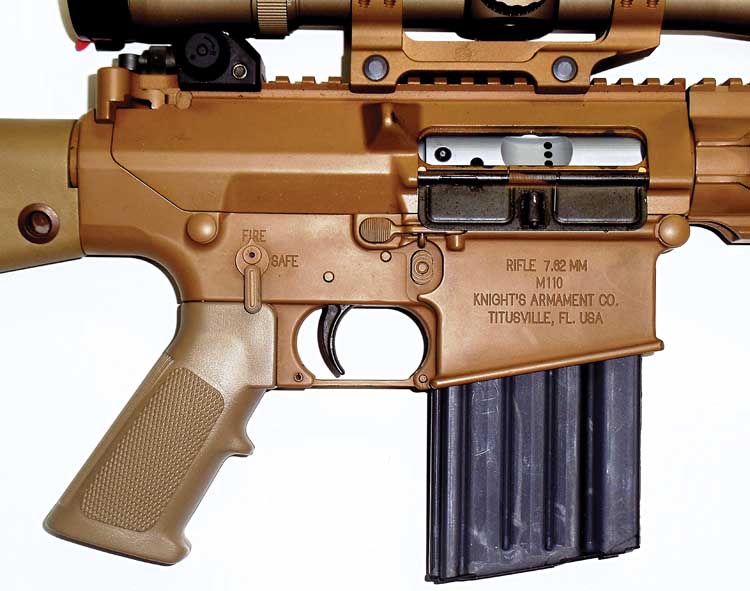
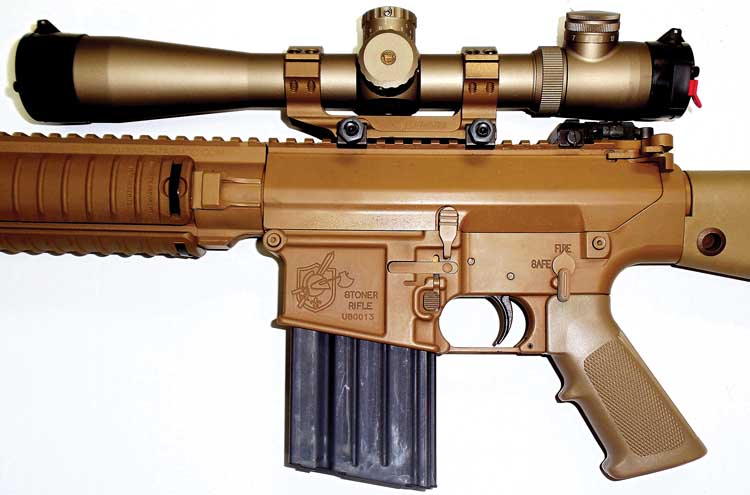
The upper receiver utilizes the new URX (Upper Receiver Extending) free floating rail with an integral folding front sight. This saves space and makes for a dependable back-up sight. The bottom of the handguard is removable for cleaning. Quad Mil-Std 1913 rails allow attachment of any accessory imaginable. The top rail is continuous for adding thermal, night vision and scopes. The handguard comes with three KAC rail protectors that allow the rifle to be shot in a normal shooting position. It is also equipped with a Harris Type S bipod. The 20 inch Obermeyer heavy barrel has 5R grooves with a 1 turn in 11 inch twist that optimizes the 168 and 175gr match bullets of the M118 and M118LR ammunition. The M110 barrel has an A2-style compensator attached to the end. The pinned-on gas block has a Mil-Std 1913 rail on top of it. The M110 is a self-regulated direct gas operated rifle. The upper receiver is manufactured from a forging and now has an integrated fired cartridge case deflector. Early rifles, due to the upper being made from an extrusion, had the fired cartridge case deflector attached to the rail as a separate piece.
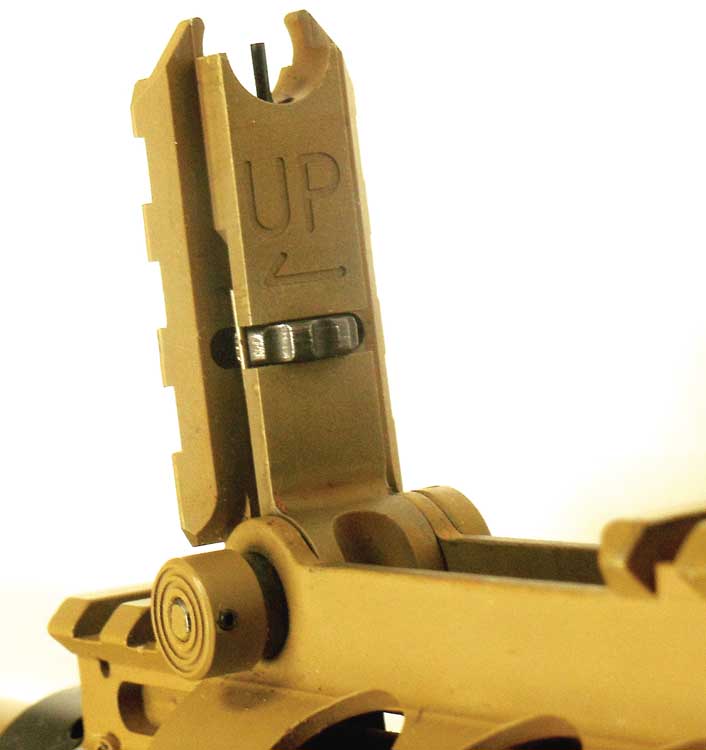
The bolt carrier group follows in the tradition of the original AR-10 in that it is chrome plated making for ease of cleaning. The bolt carrier has a captive firing pin retainer pin that prevents it from being lost during cleaning. The bolt utilizes a 1-piece gas ring that is much more durable than the standard 3-ring set. The extractor and, in particular the spring, have been enhanced since the inception of the rifle.
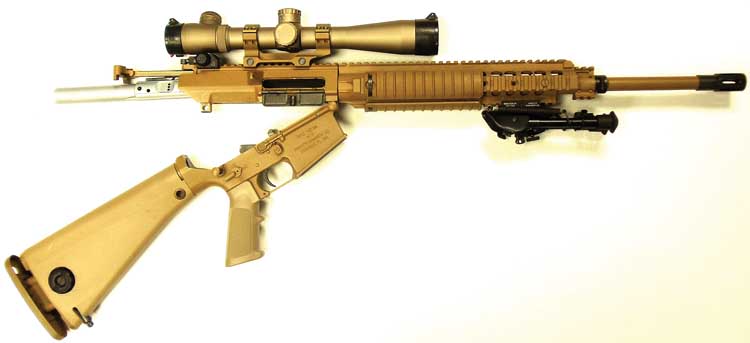
The M110 is packed with four 20-round and four 10-round magazines and pouches. The M110 can also use the Magpul LMag as well.
The optic used is the Leupold 3.5×10 Illuminated Reticle SASS scope with .5 MOA elevation clicks and 30mm SASS mount manufactured by Knight’s. The shooter can adjust the brightness of the reticle to suit the lighting conditions he faces. The scope is provided with lens covers.

The SASS also is equipped with a Knight’s Armament Company sound suppressor. The suppressor interfaces with two vertical slots cut on both sides of the gas block. There is an alignment pin on the underside of the gas block that prevents improper installation. The suppressor has a decibel reduction of -28dB.
Additional accessories include an operator’s repair parts kit that includes scope ring cap screws, bolt rings, extractor assembly, spring, pin and buffer, cam pin and firing pin. Am optics cleaning kit is provided and a torque wrench for the scope mounts. A complete cleaning system is provided as well. This includes an Otis DMR/M14 7.62 cleaning kit, Dewey rod and bore guide, multiple brushes, rod ends, pipe cleaners and swabs. Cleaning patches a bore snake and CLP is provided as well. A sling is provided as well. All this is provided in a large Hardigg box that is hermetically sealed with a pressure release valve.
The ammunition used in this test and evaluation firing was the M110 Silver State Armory (SSA) M118LR ammunition. There were 200 rounds fired with the barrel being cleaned every 10 rounds. The range was 100 meters and the rifle shot consistently sub-MOA. The best group was 5 rounds in a 1/2 inch group. The average was 3/4 inches. This is accuracy of a match bolt action rifle. Silver State Armory ammunition is match grade and they manufacture their own brass cartridge cases and blend their own powders to the particular load. Additional rounds of the 168gr OTM ammunition were fired with the same results as the M118LR.

It this shooter’s opinion there is no bolt action rifle out there that can beat the M110 on accuracy, speed and firepower. A sniper with a M110 can easily engage the same number of targets in less than half the time a well trained sniper can with a bolt action rifle. The suppressor makes it that much better: less noise, less invitation to reveal your position and no affect on accuracy. As expected, no malfunctions of any sort were encountered with the M110.
The M110 has a weight of 12.82 pounds equipped with iron sights, bipod adapter and scope. With M118LR ammunition the muzzle velocity is 2,571 feet per second. The overall length of the M110 is 40.5 inches with the stock at its shortest setting. The sound suppressor only adds 1.62 pounds to the rifle. The maximum effective range is 875 yards and is subjective to the skill of the shooter.
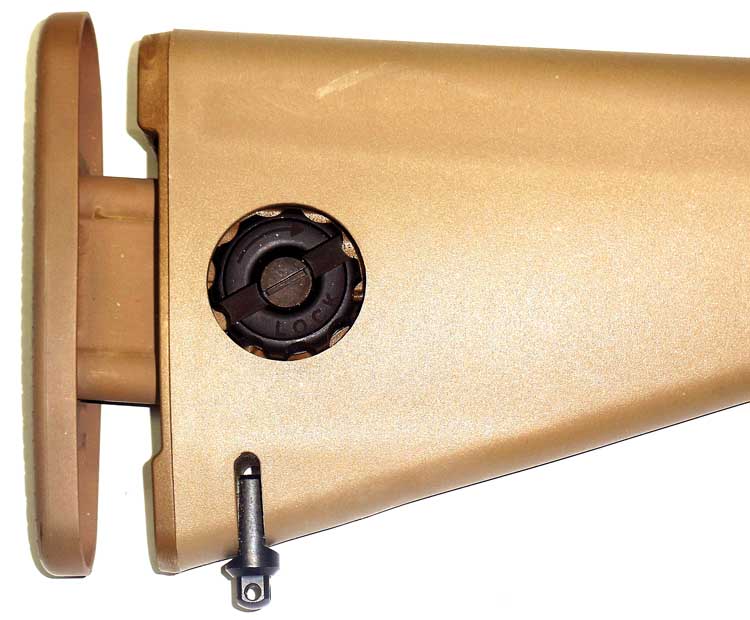
It is most unfortunate Gene Stoner did not live to see his AR-10 finally get into the U.S. inventory and equip the most elite snipers this world has ever known. He was way ahead of everyone in the late 1950s; they just did not have the vision to see it. Gene Stoner’s legacy has been the defense of this country and allies for nearly 50 years and being one of the most brilliant weapons designers of all time. Thanks to Reed Knight, Stoners vision was realized, produced and reintroduced to the U.S. military. Combining the genius of Gene Stoner with Knight’s technical and manufacturing abilities of KAC, the AR-10 will be with us for another 50 years.
| This article first appeared in Small Arms Review V15N1 (October 2011) |











